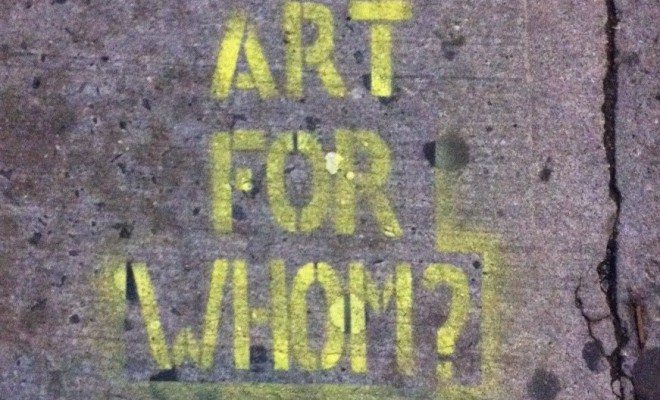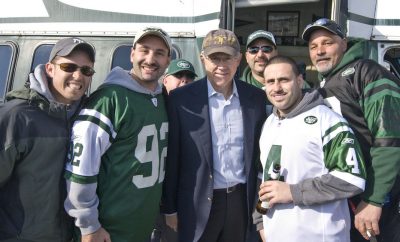
Society and Culture
‘Art for Whom?’: Bushwick Open Studios 2014
This weekend marked the eighth annual Bushwick Open Studios (BOS), a local arts festival in Brooklyn, NY. BOS has become an annual summer festival, growing in size and intensity since volunteers formed Arts in Bushwick, a non-hierarchical council of artists and community members in 2007. The event now encompasses five districts (nearly 600 venues), featuring open air concerts, food trucks, and even community garden initiatives. According to Arts in Bushwick, BOS has become “one of the largest open studio events in the world,” which I am nearly inclined to believe.
Last summer was my first Open Studios experience, and while I was not wholly impressed with the art, I was overwhelmed by the event as a community-oriented phenomenon. BOS 2013 coincided with numerous local block parties, hosted by working-class Hispanic families who welcomed me with free food and drink; it was an altogether heartwarming experience. This year, while there very well may have been neighborhood block parties, BOS was much different. I surveyed the scene on Sunday, accompanied by my partner, Amy Lucker, an art librarian, and Lee Mandel, the founding manager of Boswyck Farms, an urban farm based in Bushwick. Amy and Lee, who both served on the inaugural Arts in Bushwick council in 2007, were astounded by how large BOS had grown. “Can you believe this is Troutman Street?” Lee asked rhetorically as we navigated through the crowds of spectators, painted burlesque dancers on stilts, food vendors, and blaring concert stages. “When I moved here, this was a street you did not walk down alone.” We continued down St. Nicholas Avenue, stopping to notice a restaurant that opened that week on a site that was once a car dealership and mechanic warehouse. Bushwick is changing rapidly, we concurred; even I, who was new to the area, recognized the new boutiques, galleries, restaurants, cafes, and bars opening in the neighborhood.
It is no secret that the incursion of the “creative class” spurs gentrification. Since Lee moved to Bushwick in 2006, rent has almost tripled. Ten years ago, a two-bedroom apartment priced at $1,100 a month would have been expensive in Bushwick, according to Diana Reyna, who represented the 34th District (Williamsburg, Bushwick, and Ridgewood) on the New York City Council from 2001 to 2013. “Today we’re talking about people who are charging $3,000.” In 2011 alone, the average monthly rent for a studio apartment in Bushwick increased 27 percent, according to MNS, a residential and investment sales brokerage. Average monthly rents for one- and two-bedroom apartments have also increased commensurately. With the exponential rise in rent and cost of living it is becoming more and more difficult for working-class communities to raise families in Bushwick; it is no wonder then that I could not find bock parties at BOS 2014 as I did the year before. What is more concerning, though, is that from 2000 to 2010, the number of white residents in Bushwick has nearly doubled. “There is a lot of anxiety about the pace at which Bushwick is changing,” said Deborah Brown, an artist who served on the local community board in 2013. “It’s been faster than I could imagine.”
Beneath the surface of BOS 2014 — or rather on the surface— however, a voice of opposition raged. We noticed stenciled tags on the sidewalks throughout Bushwick, messages that critiqued the gentrification of the area.
The tags were strategically placed: two tags read “Build Community Not Condos” outside of a newly renovated apartment building and next to a low-income housing unit along Maria Hernandez Park; “increase in minimum wage = increase in living wage” outside a new health foods store.
The tags were targeted at specific indicators of gentrification, like new cafés, restaurants, and luxury apartment buildings, and the messages seem to have come from victims of gentrification. “Which is more criminal,” asked Lee, “these illegal tags, or the trash next to them on the sidewalk?” Amid Bushwick Open Studios these subversive tags challenge culture authority, asking tersely “Art For Whom?”
—
Ryan D. Purcell (@RyanDPurcell) holds an MA in American History from Rutgers University where he explored the intersection between hip hop graffiti writers and art collectives on the Lower East Side. His research is based on experience working with the Newark Public Arts Project and from tagging independently throughout New Jersey and New York.
Featured image courtesy of [Ryan D. Purcell].












Comments